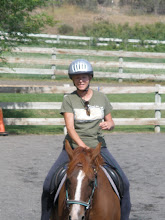Horse of a
Thousand Wishes
In the summer of after my stroke, I learned that there was a
therapeutic riding center in Winthrop, Moccasin Lake Ranch. There, Ginger, a barrel chested, gentle
chestnut mare and I were introduced.

During my first
ride, Annie, the instructor, walked Ginger and me along the trails and dirt
roads behind the center. Previously, I had been told by one of my therapists
that after sustaining a disability such as I had, to seek out new physical
activities rather trying to return to favorite ones enjoyed before the stroke;
that it would be less frustrating and more enjoyable. After my day with Ginger, I felt, I had found one. A new dream had come true.
 |
| Happy Trails to You! |
Back in Kirkland I continued to pursue riding at another
therapeutic riding center nearby, Little Bit. My new dream was developing! After 3 lessons, Little Bit
called and reported that my bone density numbers on my left hip were too low
and that I shouldn’t ride. The
reason they are so low is because I put very little weight on my left leg as I
walk due to my stroke and osteoporosis runs in my family. My dream began cloud
over. The Little Bit Riding Supervisor and I spoke for a long time. She did say
that I could ride if I signed a liability release. Unnecessarily, she explained
that any horse can spook, jump sidewise, or buck causing a fall that could
perhaps fracture my hip. This was
obvious. My love for adventure and
physical activity was tempting me to sign it, but then I began to think. If I injured myself, I would not only
impact me but I would also impact my loving husband as well, maybe even
more. This seemed so selfish as he
has done so much for me. So after
a time I decided to let go of the dream of riding at Little Bit.
Given my osteoporosis, it stands to reason that I would give
up riding at Moccasin Lake Ranch but I haven’t. Pondering this for so long has not revealed a satisfying
rationale. Subconsciously I must have recognized significant differences between Moccasin Lake Ranch and
Little Bit. Little Bit serves numerous children and adults and most lessons are
conducted in groups of 8-10. There
is very little individual attention and I ride a different horse every time. At Moccasin Lake Ranch I ride Ginger
only, a very reliable, comfortable horse.
While in the arena, Annie is always with and there are no other
horses. It is a much smaller
program. I am more comfortable and confident at Moccasin Lake Ranch than at
Little Bit.

In today’s early morning dream, I was visited by The Horse
of Thousand Wishes. As dawn’s early morning mist rose, from the hills and vales
of the landscape, an empty, almost desolate camp was revealed. No sounds of
active campers, eager to mount their ponies. No comfortable nickering among the equine friends huddled
together in the paddock.
Sweet Ginger, usually saddled, tacked and ready for me, was
not there. Neither was Annie. There instead was Safire, the Arabian,
the one I rode at Little Bit with her fast, erratic, bouncing, uncomfortable
trot. Was she for me? Was I to
ride her? Most campers did
not as she is an erratic, uncomfortable mount. Excitement and trepidation
flooded me. Should I get on? The stable hand saying nothing,
beckoned me to the mounting ramp. Ready to help. Could I ride her? Should I rider her? My adventuresome
spirit urged me to squeeze my right leg on her side. Her spirited walk startled me, unlike Ginger’s mild
plodding. Should I be doing
this? Sure! Kick her into a
trot! No, into a canter!! Yes! I’ve dreamed of getting this far for so long! But wait. “Bone density”, “any horse can spook”. “Do you want to risk a broken hip?”
I woke up. Hip? Still in good shape. Phew!
The wee hours during which Sapphire visited my dream today
have often been occupied by dreams of wishes; running, waving to a friend with my left
arm, walking barefoot, holding a baby; the return of simple pleasures
really. But when I awaken, these
dreams canter away on the back on the Horse of a Thousand Wishes.
Watch the trailer!







